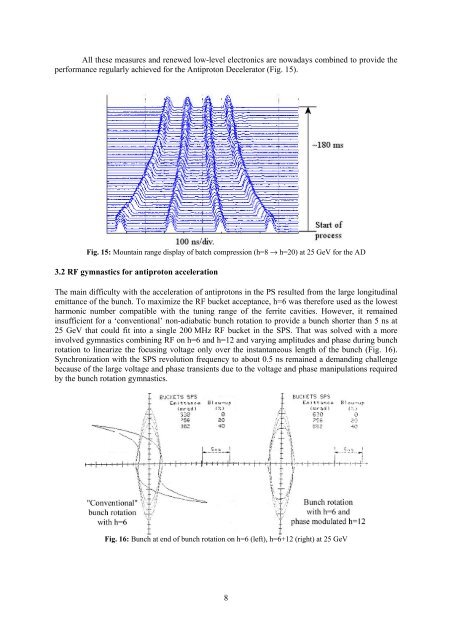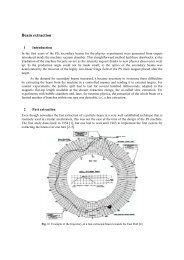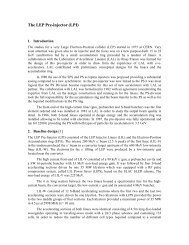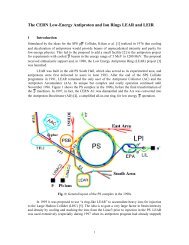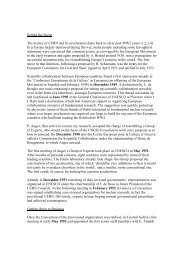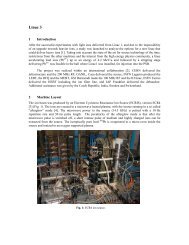RF gymnastics in the PS - CERN
RF gymnastics in the PS - CERN
RF gymnastics in the PS - CERN
Create successful ePaper yourself
Turn your PDF publications into a flip-book with our unique Google optimized e-Paper software.
All <strong>the</strong>se measures and renewed low-level electronics are nowadays comb<strong>in</strong>ed to provide <strong>the</strong>performance regularly achieved for <strong>the</strong> Antiproton Decelerator (Fig. 15).Fig. 15: Mounta<strong>in</strong> range display of batch compression (h=8 → h=20) at 25 GeV for <strong>the</strong> AD3.2 <strong>RF</strong> <strong>gymnastics</strong> for antiproton accelerationThe ma<strong>in</strong> difficulty with <strong>the</strong> acceleration of antiprotons <strong>in</strong> <strong>the</strong> <strong>PS</strong> resulted from <strong>the</strong> large longitud<strong>in</strong>alemittance of <strong>the</strong> bunch. To maximize <strong>the</strong> <strong>RF</strong> bucket acceptance, h=6 was <strong>the</strong>refore used as <strong>the</strong> lowestharmonic number compatible with <strong>the</strong> tun<strong>in</strong>g range of <strong>the</strong> ferrite cavities. However, it rema<strong>in</strong>ed<strong>in</strong>sufficient for a ‘conventional’ non-adiabatic bunch rotation to provide a bunch shorter than 5 ns at25 GeV that could fit <strong>in</strong>to a s<strong>in</strong>gle 200 MHz <strong>RF</strong> bucket <strong>in</strong> <strong>the</strong> S<strong>PS</strong>. That was solved with a more<strong>in</strong>volved <strong>gymnastics</strong> comb<strong>in</strong><strong>in</strong>g <strong>RF</strong> on h=6 and h=12 and vary<strong>in</strong>g amplitudes and phase dur<strong>in</strong>g bunchrotation to l<strong>in</strong>earize <strong>the</strong> focus<strong>in</strong>g voltage only over <strong>the</strong> <strong>in</strong>stantaneous length of <strong>the</strong> bunch (Fig. 16).Synchronization with <strong>the</strong> S<strong>PS</strong> revolution frequency to about 0.5 ns rema<strong>in</strong>ed a demand<strong>in</strong>g challengebecause of <strong>the</strong> large voltage and phase transients due to <strong>the</strong> voltage and phase manipulations requiredby <strong>the</strong> bunch rotation <strong>gymnastics</strong>.Fig. 16: Bunch at end of bunch rotation on h=6 (left), h=6+12 (right) at 25 GeV8


